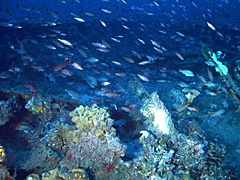
|
|
National Marine Sanctuary Program
The National Marine Sanctuary Program (NMSP) manages and protects 13 sanctuaries and one coral reef ecosystem reserve encompassing over 150,000 square miles of U.S. ocean. Important habitats like breeding and feeding grounds of whales, sea lions, sharks and sea turtles; coral reefs; kelp forests; and historic shipwrecks are represented within the system of sanctuaries. In the Atlantic, remains of the Civil War ironclad, the USS Monitor, are protected within a sanctuary. Gray’s Reef, Stellwagen Bank and the Florida Keys sanctuaries manage and protect coral reefs, important fishing grounds, loggerhead turtles and right whale habitat. The most recently designated sanctuary, Thunder Bay in Lake Huron, manages and protects a wealth of historic shipwrecks--an area dubbed “Shipwreck Alley.”
Each sanctuary maintains an on-site field staff that conducts research and monitoring, resource protection, and educational activities. Research and monitoring programs evaluate the status and health of marine species, habitats, and ecosystems in support of resource protection efforts. Resource protection activities use a variety of means including regulations and permits, emergency response activities, enforcement and education to reduce or prevent detrimental human impacts. Education and outreach activities are used to enhance public understanding and stewardship of the sanctuaries, and range from public events and interactive teacher workshops to extensive written materials.
At the national level, NMSP works in cooperation with field staff to develop policy for managing sanctuaries, issue permits for certain uses of the sanctuaries, and review sanctuary management plans. It also establishes a national plan and framework for scientific research activities conducted at the field sites; conducts damage assessments of sanctuary resources that have been marred by boat groundings, spills, and anchors; applies socio-economic analysis to proposed management actions; carries out inventories of cultural resources; and uses geographic information systems to map sanctuary resources. The program also implements a national marine sanctuary education plan to support hundreds of educational activities and events throughout the sanctuary system. (top) |
|
|||||||||||||||||||||||
|
|||||||||||||||||||||||||
|
Revised May 12, 2004 | Questions, Comments? Contact Us | Report Error On This Page | Disclaimer | User Survey |


